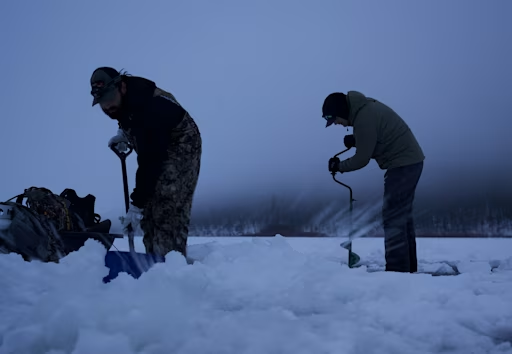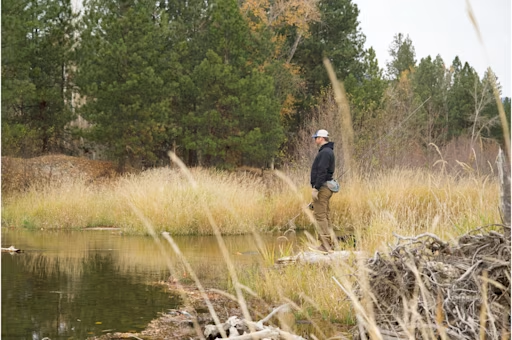Fishing for post spawn pike
How to find and target northern pike after they spawn.
Share this article

As water warms and the further you get from the spawn, pike will gradually move into deeper water and habitat weedbeds
Reel in baits just fast enough to keep them off the bottom of the lake/river
Spawning starts from late March to early April, whenever ice breaks up and water temps reach close to 40 degrees Fahrenheit
The ice is broken, or breaking everywhere across the country, open water fishing is here and our favorite toothy predators are in the middle of their yearly ritual of repopulation. The pike spawn is on, and while the ethics of fishing during spawn time are murky at best within the fishing community, post spawn is one of the best times to target big, hungry, water wolves.
Pike are one of the most dispersed species across the country. Fishbrain’s own Director of Product & Engineering Riku Vuorenmaa is a big pike tournament angler, as well as a self diagnosed pike enthusiast. Below he shares some of his favorite tips for targeting post spawn pike during this exceptional time of year.
Where to find post spawn pike

Spring, ice off, warmer waters and the spawn all bring pike from deep waters and into the shallows. Searching for baitfish and warmth drives pike into these shallow waters. Spawning depletes a pike’s fat reserves and weight therefore after repopulating, they are in search of as many easy meals as possible. Bait fish often spawn in somewhere around two to four feet of water in spring and where there is food there will be pike.
Vuorenmaa suggests searching lake inlets, bays and the mouths of rivers and creeks as excellent spots where baitfish congregate. As spring wears on, as pike pack their weight back on and as the water temperatures rise, start looking for fish in weed beds in deeper waters.
At this time Vuorenmaa also advises to keep an eye out for any lingering spawning pike and to leave them alone. He adds that pike that have spawned very recently will linger in these areas, as well, and should be left alone to recover their strength.

For truly large pike Vuorenmaa suggests using underwater charts, like Garmin's, to search for deep trenches, drop offs and potholes on the edges of spawning areas. The biggest pike will likely wait in these slightly deeper edge territories when the temperatures are still chilly, before moving into the shallow waters.
Note: Pike won’t spawn at the same time, so even if you see them in the spawning area, there’s likely some feeding fish still outside of the spawning areas, getting ready for spawn, or already bulking up after the spawn.
Post spawn pike baits

Cold water means slow retrieves are the name of the game. Pike may be hungry, but the cold water keeps their metabolism slow. Vuorenmaa advises using long tailed jigs as they create great action at slower speeds.
Vuorenmaa goes on to say while your retrieve should be slow it should still be fast enough to stay off the bottom of the lake, or river. Make sure to not use too much weight in these situations and monitor your jig, or lure, constantly to make sure it is moving in the right depth as you switch from spot to spot.
You can also try using a heavy fluorocarbon line instead of a bite wire when fishing shallow water, if you’re having trouble keeping a slow retrieve and your lure off the bottom.

Most types of lures work this time of year. Jerk baits, big jigs, swimbaits, big spin baits, are all perfect choices, and usually there is no need for any smaller baits. You should choose colors and bait type according to the water conditions, depth & available baitfish population.
Lures mimicking small pike are also a go to option this time of year as female pike will often eat their male suitors as a quick post spawn snack.
More tips for spring pike

Spring snowmelt will often murky up the water especially if you’re fishing a river, or where one runs into a lake. Just because the water is muddy, doesn't mean pike aren’t feeding. In fact they may feel more secure in the cover of cloudy water as they are ambush predators. You will still need to get their attention, however, by using bright colors with a lot of flash.
Follows without a take are a site most pike anglers have experienced and Vuorenmaa has one possible explanation and solution to this infuriating situation. He says, this time of year, pike are feeding so heavily to regain their weight, they may be following your lure instinctively, but are too full to actually take your lure. If you’re feeling frustrated by this situation, he suggests scaling down your lures as a smaller fish may be just a snack to a hungry pike that has already gorged itself.
Bigger pike quite often stay around shallow areas after the spawn, especially if the water doesn’t warm up quickly, and feast on other species that spawn after the pike. When the water temperature starts to hit over 60 degrees, most of the bigger pike will move to cooler water in deeper areas.

When the water starts getting into the above range, you can begin speeding up your retrieve as pike metabolisms and energy levels will rise and make them more aggressive.
The water wolves are out and there is no better time to be on the open water and targeting them. With the above tips and Fishbrain in your tackle box you should be well suited to make this spring one of your best.
Now let’s go fishing. We’ll bring the tournament pike angler.
If you haven't experienced the #1 fishing app worldwide, make sure and check out Fishbrain to see all the fish data, fishing spots, weather conditions you've been missing out on plus much more.

Download the Fishbrain app and access the best fishing spots in your area
Related blog posts
Discover the best spots, techniques, and gear for successful fishing in urban areas and city waters on Fishbrain.

Master the hardwater season with advanced ice fishing tips . Learn how to find fish faster, refine your search and adjust presentations to catch more fish all winter long.

Your guide to Victoria’s best fish to catch in rivers, lakes, and coastal waters. Learn prime species, fishing tips, and key regulations




